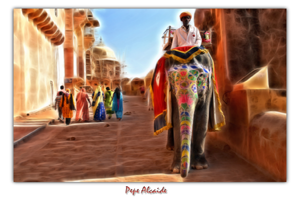
Day 01: Delhi
Arrival Delhi transfer to hotel. Overnight at hotel.
Day 02: Full day visit of Delhi
Visit Old Delhi: Visit Jama Mosque (1650 A.D) and drive through fabled Chandni Chowk (Moonlight Square), the main area of the old city. Visit the Red Fort (1639-48 A.D),built by the builder of the Taj Mahal – Shah Jehan and famous for its delicately carved, inlaid and marbled Royal Chambers. Raj Ghat – where the Father of the Nation, Mahatma Gandhi was cremated (1948 A.D), visit New Delhi : Visit Humayun’s Tomb (1565 A.D) aptly called the redecessor of Taj Mahal. Drive past Safdarjung’s Tomb (1753 A.D), and visit the Qutub Minar – 72 meters high and one of the prefect towers of the Persian World. Overnight at hotel
Day 03: Delhi / Mandawa – 260 kms, 5-6 hours drive
Drive Delhi to Mandawa, afternoon visit Mandawa’s beautiful frescoes, havelies and mansions. Overnight at hotel.
Day 04: Mandawa / Bikaner – 170 kms 4 hours drive
Drive Mandawa/ Bikaner, Sightseeing of Bikaner includes Bikaner Fort & local Bazaar; overnight at hotel.
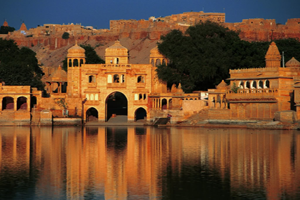
Day 05: Drive Bikaner / Jaisalmer
Drive to Jaisalmer, 5 hours drive, sightseeing of Jaisalmer that lies in the heart of the Thar. People still live in ancient buildings dating from 12th to 15th century. Every house has exquisite carvings and filigreed work.Visit the different Havelies, Gadisagar Lake, Jaisalmer Fort & Bada Bagh. Overnight in Hotel.
Day 06: Drive Jaisalmer/ Jodhpur – 305 kms, 5 hours drive
Drive to Jodhpur, afternoon visit of the Meharangarh Fort; Visit Jaswant Thada, an imposing Marble Memorium; Visit Mandore, the ancient capital of Marwar was abandoned for strategic reasons. Overnight at Hotel.
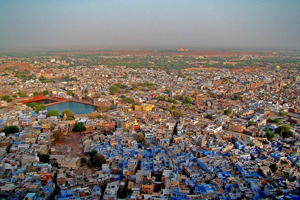
Day 07: Jodhpur – Jaipur 5 hours drive
After breakfast drive to Jaipur, afternoon visit:
City Palace – The beautiful architecture of this palace combines elements of Rajput finesse, Mughal spaciousness and English linear planning.
Jantar Mantar – An astronomical observatory built by Sawai Jai Singh II, is quite mordern for its times. Here the Maharaja used to read skies, stars and forecast about the rainfall. Overnight at hotel
Day 08: Jaipur – Fatehpur Sikri – Agra (240 kms, 5 hours drive + 2 hours for Fatehpur Sikri visit)
Breakfast at hotel, visit Hawa Mahal – The most recognisable monument in Rajasthan, the Palace of Winds, was built in 1799 by Maharaja Pratap Singh. It was used as a place for the queens to observe the markets below, away from the public.
Amber Fort – Elephant ride to Amber Fort which was the capital of Jaipur in ancient times. Raja Man Singh I built the fort of Amber in 11th century northeast of Jaipur. The Amber Palace is a good example of courtly gardens, landscaped with artificial lakes and terraces. After the visit drive to Agra en route visiting “FATEHPUR SIKRI” the deserted city of Emperor Akbar literally means “The city of victory”. The audience halls, palaces and the mosques are still in a state of perfection as are the Tomb of Sheikh Salim histi, Panchmahal, Buland Darwaza, Diwan-i-Am, & Diwan-i-Khas. Arriva Agra & overnight at hotel
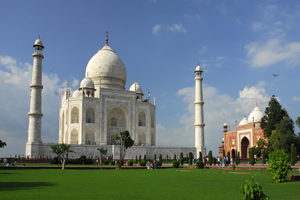
Day 09: Agra visits & overnight train Agra / Varanasi
After breakfast, visit Agra Fort – The imposing fort on the banks of the river Yamuna is replete with priceless example of craftsmanship in the Mughal period, including the beautiful Pearl Mosque. It was designed and built by the Mughal Emperor Akbar in 1565 A.D. Visit Taj Mahal – One of the Seven Wonders of the World, built by Emperor Shah Jehan in memory of his beloved consort Mumtaz Mahal, this beautiful mausoleum is pure white marble and an architectural marvel. Later transfer to railway station for overnight train to Varanasi.
Day 10: Varanasi
Arrival Varanasi station, transfer to hotel, day free to walk around Ghats. Overnight at hotel.
Day 11: Varanasi
Boat ride in the river Ganga; Sightseeing of Varanasi includes visit to Bharat Mata Temple, Durga Temple, Emperor Aurangzeb’s Mosque, Vishwanath Temple.
Afternoon visit Sarnath; Sarnath the tranquil deep park at Sarnath is where the Buddha preached hid first sermon. Visit the Dhamok Stupa, the Dharmarji Ka Stupa and maon shrine. The Mahabodhi Society of India have recently built a modern Vihara, Ashoka Pillar Erected by the Emperor Ashoka, the pillar had his edict engraved on it. At one time it stood over 17m high. Its capital with the four lions back to back-the official symbol of modern India, can be seen in the museum at Sarnath. Overnight at hotel.

Day 12: Varanasi / Kolkata
Breakfast at hotel & later transfer to airport for flight to Kolkata at 1425 hrs, arrival Kolkata at 1540 hrs & transfer to hotel.
Day 13: Kolkata
Breakfast at hotel, full day visit of Kolkata – Today the tour of this vibrant city is begun with the Jain Temple also known as the “Jewel Box Temple of Calcutta”. It is situated in the northeast of the city. This temple of exquisite design and construction is dedicated to the 10th of the 24 Jain Tirthankaras and is an ornate mass of mirrors, colored stones and glass mosaics. After this we move to see Kumartolli (place where craftsman make idols). Kolkata is famous for its festivals (PUJAS) round the year and this is the place where the idols are made. It is very interesting to see the craftsman making idols without using any machinery. Finally we move to Marble Palace, situated in north Calcutta, it has a collection of statues and original paintings including works of Rubens and Sir Joshua Reynolds. It is a private museum owned by the Mullicks (Zamidars during the British period). We than move to College Street (one of asia’s largest book market), have a cup of coffee at the famous “Coffee Shop” where one can see the young Turks gossiping and feel the pulse of the culture.
Visit the PARK STREET CEMETRY and Kali Temple. It is a great pilgrimage center of the Hindus and is situated at Kalighat. The original temple was built some 350 years ago. A legend goes that when the corpse of sati, wife of lord Shiva was cut into pieces by the Sudarshan Chakra, one of her fingers fell here. Overnight at hotel.
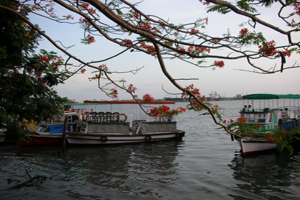
Day 14: Kolkata
Breakfast at hotel, today the tour of this sprawling city begins with the Howrah Bridge; this bridge is built on river Hooghly and connects the city of Kolkata with the industrial town of Howrah. After which you are taken to the daily flower market to see the normal life of the common man with the different colors of flower. We now drive pass the Dalhousie Square where we see the Writers Building (State Secretariat), Raj Bhawan (Governor House), General Post Office Building, Kolkata High Court, Kolkata Town Hall and the St.John’s Church. We than move to the Botanical Gardens situated on the west bank of river Hooghly covering an area of 273 acres. The main attraction of the botanical gardens is the giant size banyan tree that is said to have the second largest canopy in the world. Over here, you can find a plethora of beautiful orchids and other colorful flowers.We see the Victoria Memorial. It is a massive domed building of white marble from Rajasthan. It was inaugurated in 1921 by the Prince of Wales (later, briefly, Edward VIII). It houses a collection of Victoria memorabilia and also history related objects and documents on Bengal. In the park in which the memorial stands are statues of Queen Victoria, Lord Curzon and other figures of the Raj. Here, on weekends, people picnic, families meet for matchmaking, and transiting pilgrims bring flowers to the statue of “Maharani Victoria”.Continue on to one of the largest and most impressive museums in India, the Indian Museum, founded in 1814 on the basis of the collection of the Asiatic Society. Its widely varied exhibits include such oddities as a roomful of meteorites and a number of (stuffed) man-eating crocodiles. It has an impressive archaeology and sculpture department with a superb collection of Gandharan Buddhist art, as well as works from Khajuraho, Bhairat and many other important sites. Overnight at hotel.
Day 15: Kolkata / Onward destination
Breakfast at hotel, transfer to airport for flight to onward destination.